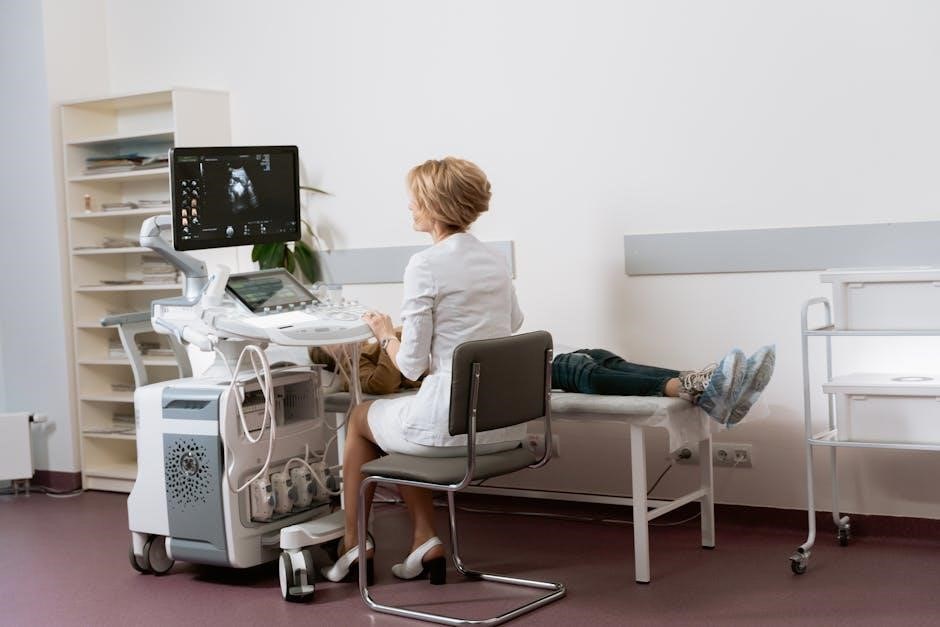The DISC Personality Test is a widely used assessment tool categorizing behavior into Dominance, Influence, Steadiness, and Conscientiousness. It enhances workplace communication, leadership, and team collaboration effectively.
Overview of the DISC Model
The DISC model is a behavioral assessment tool categorizing individuals into four primary traits: Dominance (D), Influence (I), Steadiness (S), and Conscientiousness (C). These traits reflect how people approach tasks, interact with others, and handle stress. Dominance focuses on leadership and decision-making, while Influence emphasizes communication and interpersonal skills. Steadiness highlights reliability and consistency, and Conscientiousness involves analysis and attention to detail. This framework helps identify behavioral patterns, enabling better teamwork, communication, and personal development. Widely used in workplace settings, the DISC model provides insights into individual strengths and areas for improvement, fostering effective collaboration and leadership growth.
Importance of Personality Assessments in the Workplace
Personality assessments like the DISC test are vital in workplace dynamics, enhancing communication, collaboration, and leadership. They help identify individual strengths, fostering effective team building and conflict resolution. By understanding behavioral styles, organizations can improve employee engagement and productivity. These tools also aid in recruitment, ensuring better candidate fit for roles. Additionally, they support leadership development and personal growth, enabling employees to adapt their behaviors for success. Overall, personality assessments create a harmonious work environment, driving organizational success and employee satisfaction through tailored strategies and improved interpersonal relationships.

Core Principles of the DISC Assessment
The DISC assessment focuses on four core principles: Dominance, Influence, Steadiness, and Conscientiousness. These principles help individuals understand their behavioral styles to enhance communication and teamwork effectively;
Dominance (D): Leadership and Decision-Making
Individuals with a high Dominance (D) score are assertive, results-driven, and comfortable taking charge. They excel in leadership roles, making quick decisions and setting clear goals. Their confidence and competitive nature help them navigate challenges effectively. However, they may struggle with flexibility and delegating tasks. In the workplace, D-style personalities thrive in fast-paced, competitive environments where they can assert control and achieve tangible outcomes. Their natural leadership abilities make them effective in driving projects forward, though they may need to balance their assertiveness with empathy to foster stronger team relationships. Understanding this trait helps individuals leverage their strengths while addressing potential limitations in collaboration and adaptability.
Influence (I): Communication and Interpersonal Skills
Individuals with a high Influence (I) score are outgoing, enthusiastic, and excel in interpersonal communication. They thrive in social environments, building rapport and motivating others through their optimism and charisma. Their strength lies in fostering collaboration and creating a positive atmosphere. However, they may prioritize harmony over efficiency, potentially leading to indecision. In the workplace, I-style personalities are natural networkers and motivators, often excelling in roles requiring strong people skills. They are adept at conflict resolution and team engagement, though they may need to focus on task-oriented outcomes. Understanding this trait helps individuals harness their communication strengths while balancing their tendency to seek consensus over results.
Steadiness (S): Reliability and Consistency
Steadiness (S) reflects reliability, consistency, and a calm demeanor. Individuals with high S scores are patient, stable, and good listeners, valuing harmony and predictability. They excel in maintaining routines and providing support, often acting as the backbone of a team. Their strength lies in loyalty and dependability, making them trustworthy colleagues. However, they may resist change and hesitate in decision-making due to a preference for stability. In the workplace, S-style personalities thrive in roles requiring attention to detail and long-term commitment. They ensure tasks are completed thoroughly, though they may need encouragement to embrace new challenges and adapt to rapid changes.
Conscientiousness (C): Analysis and Attention to Detail
Conscientiousness (C) emphasizes precision, organization, and a methodical approach to tasks. Individuals with high C scores are analytical, detail-oriented, and value structure. They excel in planning, organizing, and ensuring accuracy, often acting as the team’s quality control. Their cautious nature helps in identifying potential risks and improving processes. However, they may overanalyze decisions, leading to indecision. In the workplace, C-style personalities thrive in roles requiring meticulous attention to detail, such as auditing or technical positions. Their reliability ensures tasks are completed to high standards, though they may benefit from trusting their instincts and embracing flexibility in dynamic environments.

How the DISC Test Works
The DISC test evaluates behavioral traits through a series of questions, measuring Dominance, Influence, Steadiness, and Conscientiousness. Results create a personalized profile for self-awareness and improvement.
The Assessment Process: Questions and Formats
The DISC assessment typically consists of 24-30 multiple-choice questions, each presenting four behavioral options. Participants select the most and least descriptive statements about themselves. The test is designed to be straightforward, with most individuals completing it in 10-15 minutes. The questions focus on common workplace scenarios to gauge natural and adapted behaviors. Results are analyzed to determine the individual’s DISC profile, highlighting strengths and areas for improvement. The format is user-friendly, often available online or in print, ensuring accessibility. Immediate results provide a detailed report, making it a practical tool for personal and professional development. This process ensures accurate insights into behavioral tendencies.
Interpreting DISC Results: Understanding Your Profile
DISC results are presented in a graph showing the prominence of each trait (D, I, S, C) in an individual’s behavior. The profile highlights strengths, areas for improvement, and tendencies in workplace interactions. The results are personalized, offering insights into communication styles, decision-making, and problem-solving approaches. Understanding your profile helps identify how you adapt behaviors in different situations. The report also provides actionable recommendations for personal and professional growth. By analyzing the results, individuals can enhance their self-awareness, improve relationships, and align their behaviors with organizational goals. This interpretation is key to leveraging the DISC model effectively for development and collaboration. The insights gained are practical and applicable in real-world scenarios.
Applications of the DISC Personality Test
The DISC Personality Test improves workplace communication, enhances team collaboration, and aids in conflict resolution. It also supports leadership development and recruitment by aligning behaviors with organizational needs effectively.
Improving Workplace Communication
The DISC Personality Test enhances workplace communication by helping individuals understand their own and others’ behavioral styles. By identifying Dominance, Influence, Steadiness, and Conscientiousness traits, employees can adapt their communication approaches to foster collaboration. This reduces misunderstandings and improves teamwork. For instance, a Dominance-style individual may prefer direct communication, while a Steadiness-style person might need more detailed explanations. Understanding these preferences allows for tailored interactions, promoting empathy and alignment. Organizations can use DISC insights to create a culture of open dialogue, ensuring all voices are heard and valued. This leads to a more inclusive and productive work environment, driving overall success. Effective communication is key to achieving shared goals.
Enhancing Team Collaboration
The DISC Personality Test is a powerful tool for enhancing team collaboration by fostering mutual understanding and respect among members. By identifying individual behavioral styles—Dominance, Influence, Steadiness, and Conscientiousness—teams can better align their strengths and minimize conflicts. For example, a Dominance-style leader can focus on decision-making, while a Steadiness-style member ensures stability and consistency. Understanding these dynamics helps teams balance task-oriented and people-focused approaches, leading to more effective problem-solving. DISC insights also encourage open dialogue, allowing team members to adapt their communication styles to support one another. This harmonization of efforts creates a cohesive and productive environment, essential for achieving shared goals and driving organizational success.
Identifying Leadership Potential
The DISC Personality Test is a valuable tool for identifying leadership potential by highlighting key traits like decision-making, communication, and problem-solving skills. Individuals with a Dominance (D) style often exhibit strong leadership qualities, thriving in assertive roles. Those with an Influence (I) style excel at inspiring and motivating others, fostering a collaborative environment. Steadiness (S) individuals demonstrate reliability and consistency, essential for stable leadership. Conscientiousness (C) styles bring analytical rigor, ensuring well-considered decisions. By understanding these behavioral tendencies, organizations can better identify and nurture potential leaders, aligning their strengths with leadership roles. This insight helps develop effective leaders who drive success and foster a positive workplace culture.
Conflict Resolution Strategies
The DISC Personality Test provides insights into conflict resolution by understanding individual behavioral styles. Dominance (D) styles tend to assert control, while Influence (I) styles seek collaboration. Steadiness (S) styles prioritize harmony, and Conscientiousness (C) styles focus on analysis. By recognizing these tendencies, teams can adapt strategies to address conflicts effectively. For example, D styles may need to balance assertiveness with empathy, while C styles should avoid overanalyzing. Encouraging open communication and leveraging each style’s strengths fosters resolution. DISC helps identify potential friction points and promotes constructive dialogue, enabling teams to resolve conflicts efficiently and maintain a positive work environment. This approach ensures conflicts are managed productively, enhancing overall collaboration and productivity.

The Science Behind the DISC Assessment
The DISC assessment is rooted in psychological research, focusing on behavioral patterns. It is validated through studies, ensuring its effectiveness in understanding individual styles and workplace interactions effectively.
Psychological Foundations of the DISC Model
The DISC model is rooted in the work of William Moulton Marston, who identified four behavioral traits: Dominance, Influence, Steadiness, and Conscientiousness. These traits reflect how individuals respond to their environment and interact socially. The theory suggests that behavior is driven by emotional responses and social interactions, providing a framework to understand personality in a workplace context. While not a traditional psychological theory, DISC offers practical insights into behavioral tendencies, aiding in communication, leadership, and team dynamics. Its simplicity and focus on observable behaviors make it a popular tool for personal and professional development, though it is not scientifically validated as a personality theory.
Research Supporting the DISC Framework
While the DISC model is not rooted in traditional psychological theory, it has gained acceptance through practical application and empirical studies. Research indicates that DISC assessments reliably measure behavioral tendencies, with studies validating their consistency and reliability. For instance, studies have shown that DISC profiles can predict leadership effectiveness and team dynamics. Additionally, its simplicity and focus on observable behaviors make it a valuable tool for workplace communication and collaboration. However, critics argue that DISC lacks the depth of more comprehensive personality models. Despite this, its widespread use in corporate settings underscores its practical value for understanding and improving workplace interactions.
Using DISC for Personal Growth
The DISC Personality Test helps individuals gain self-awareness, improve communication, and make informed decisions. It fosters personal and professional development by understanding strengths and behavioral tendencies effectively.
Self-Awareness and Behavioral Adaptation
The DISC Personality Test enhances self-awareness by revealing individual behavioral tendencies and communication styles. It helps identify strengths and areas for improvement, fostering personal growth. By understanding their DISC profile, individuals can adapt their behavior to better align with professional and personal goals. This awareness enables more effective decision-making and improved interpersonal interactions. The test also encourages empathy and understanding of others’ behaviors, promoting harmony in relationships. Through self-reflection and insights, individuals can develop strategies to modify their actions, leading to greater success and satisfaction in both personal and professional spheres. This adaptability is a key benefit of the DISC assessment.
Professional Development Opportunities
The DISC Personality Test offers valuable insights for professional growth by identifying strengths and areas for improvement; It helps individuals understand their communication style and decision-making tendencies, enabling them to tailor their development plans. By recognizing their behavioral preferences, professionals can enhance leadership skills, improve collaboration, and adapt to workplace demands. The test also highlights potential career paths aligned with their personality traits, fostering career satisfaction. Organizations use DISC to create targeted development programs, ensuring employees grow in roles that suit their strengths. This personalized approach to growth fosters a more engaged and effective workforce, driving both individual and organizational success.
Building Stronger Relationships
The DISC Personality Test is a powerful tool for fostering stronger relationships by helping individuals understand and appreciate differing communication styles. By identifying personal behavioral preferences, individuals can adapt their approach to others, enhancing empathy and understanding. This leads to more effective communication and conflict resolution. The test also highlights how to leverage complementary traits, building trust and collaboration. In both personal and professional settings, DISC insights enable individuals to navigate interactions more thoughtfully, leading to deeper connections and more harmonious relationships. This awareness fosters mutual respect and strengthens bonds, making it easier to work together toward common goals.

DISC in Recruitment and Hiring
DISC assessments are often used in recruitment to evaluate candidate fit for roles, helping employers understand behavioral styles and communication preferences, though limitations exist.
Assessing Candidate Fit for Roles
The DISC assessment is widely used in recruitment to evaluate how well candidates align with specific roles and company cultures. By analyzing behavioral styles, employers can identify whether a candidate’s tendencies match the job requirements. For instance, a high Dominance (D) score may suit leadership roles, while Steadiness (S) is often preferred for consistent, reliable positions. This tool helps organizations reduce hiring risks and improve team dynamics. However, it’s important to note that DISC should not be the sole decision-making factor, as it doesn’t assess skills or experience. Combining DISC insights with other evaluation methods ensures a more comprehensive candidate assessment.
Limitations of DISC in Recruitment
While the DISC assessment is valuable for understanding behavioral styles, it has limitations in recruitment. It does not measure technical skills, experience, or cognitive abilities, which are critical for role suitability. Additionally, candidates may adapt their responses to fit perceived job expectations, leading to less accurate results. The tool’s focus on communication styles rather than competencies can result in overlooking qualified candidates. Furthermore, interpreting DISC profiles requires expertise to avoid biases. Relying solely on DISC for hiring decisions may lead to incomplete evaluations. Therefore, it’s essential to combine DISC insights with other assessment methods for a more comprehensive candidate evaluation.

Advanced DISC Strategies
Advanced DISC strategies involve combining the model with other assessments for deeper insights, integrating it into leadership programs, and using it to enhance team-building activities and effectiveness.
Combining DISC with Other Assessment Tools
Combining DISC with other assessment tools, such as TTI or Myers-Briggs, provides a more comprehensive understanding of personality and behavior. This integration allows for deeper insights into an individual’s strengths, weaknesses, and motivations. For instance, while DISC focuses on observable behaviors, tools like TTI’s Motivators assess underlying drivers, creating a holistic view. This approach is particularly useful in leadership development, where understanding both behavior and motivation is crucial. Organizations can leverage these combined insights to create tailored development plans, enhancing both individual and team performance. By merging DISC with other frameworks, professionals can address a broader range of interpersonal and operational challenges effectively.
Using DISC in Leadership Development Programs
The DISC assessment is a valuable tool in leadership development, helping individuals identify their natural leadership styles and areas for improvement. By understanding their behavioral tendencies, leaders can adapt their approach to better align with team needs. For example, a Dominance-style leader may focus on decision-making and goal-setting, while an Influence-style leader might prioritize communication and motivation. Leadership programs often incorporate DISC to enhance self-awareness, improve decision-making, and foster effective communication. This approach enables leaders to leverage their strengths while developing strategies to address potential weaknesses, ultimately creating a more balanced and impactful leadership presence within their organizations.
Integrating DISC into Team-Building Activities
Integrating the DISC personality test into team-building activities fosters a deeper understanding of individual behavioral styles, enhancing collaboration and communication. Workshops often involve sharing DISC profiles, allowing team members to recognize how their tendencies complement or contrast with others. This insight helps reduce conflicts and improve productivity. Practical exercises, such as role-playing or group projects, encourage participants to apply their DISC knowledge in real-world scenarios. By leveraging these strategies, teams can create a more harmonious and effective work environment, ensuring that diverse personalities work together seamlessly toward common goals. This approach strengthens interpersonal connections and elevates overall team performance.

Comparing DISC to Other Personality Tests
DISC focuses on observable behavior, unlike Myers-Briggs or Big Five, offering practical insights for workplace communication and team dynamics, making it a unique tool for professional development.
Myers-Briggs Type Indicator (MBTI)
The Myers-Briggs Type Indicator (MBTI) is a popular personality assessment that categorizes individuals into 16 distinct types based on four dichotomies: Extraversion vs. Introversion, Sensing vs. Intuition, Thinking vs. Feeling, and Judging vs. Perceiving. Unlike the DISC model, which focuses on observable behaviors, MBTI delves deeper into cognitive preferences and emotional tendencies. While DISC is often used for workplace communication and team dynamics, MBTI is broader, exploring how individuals perceive and interact with the world. Both tools aim to enhance self-awareness but differ in their approaches and applications, making them complementary rather than competing frameworks for understanding personality.
Big Five Personality Traits
The Big Five Personality Traits, also known as the Five Factor Model, categorizes personality into five broad dimensions: Openness, Conscientiousness, Extraversion, Agreeableness, and Neuroticism. Unlike the DISC model, which focuses on workplace behavior, the Big Five provides a more comprehensive view of personality, encompassing emotional and cognitive aspects. Openness reflects curiosity and creativity, while Conscientiousness relates to organization and responsibility. Extraversion measures sociability, Agreeableness assesses empathy, and Neuroticism evaluates emotional stability. This framework is widely used in psychological research and offers insights into personal growth, relationships, and career alignment, making it a valuable complement to tools like DISC in understanding human behavior and development.

Case Studies and Real-World Applications
Organizations worldwide use DISC to enhance team collaboration, improve leadership, and resolve conflicts. Real-world applications include workplace communication, employee development, and strategic decision-making, driving measurable success across industries.
Success Stories from Organizations Using DISC
Many organizations have reported significant improvements after implementing DISC assessments. Companies in tech and healthcare have enhanced communication and leadership, fostering a more collaborative environment. For instance, a leading tech firm used DISC to resolve internal conflicts, resulting in increased productivity. Healthcare providers leveraged DISC to improve patient care by aligning team behaviors with patient needs. Educational institutions have also adopted DISC to enhance faculty and student interactions. These success stories highlight how DISC insights can drive measurable outcomes, from improved employee retention to better customer satisfaction. By understanding behavioral styles, organizations create a culture of empathy and efficiency, leading to long-term success;
Overcoming Challenges with DISC Insights
DISC assessments have proven instrumental in addressing workplace challenges by providing actionable insights. For instance, organizations have used DISC to resolve communication gaps, improve conflict resolution, and enhance leadership effectiveness. By understanding individual behavioral styles, teams can adapt their approaches to foster collaboration. For example, a company facing internal conflicts leveraged DISC to identify differing communication styles and tailored strategies to align team behaviors. Similarly, DISC insights have helped organizations improve recruitment processes by better matching candidates to role requirements. These applications demonstrate how DISC can transform challenges into opportunities for growth, leading to improved workplace dynamics and employee satisfaction.

The Future of DISC Assessments
Technological advancements and evolving workplace dynamics are reshaping DISC assessments, enhancing their accessibility and integration with modern tools for improved personality insights and workplace applications.
Technological Advancements in Personality Testing
Technological advancements are revolutionizing personality testing, with AI and machine learning enhancing the accuracy and accessibility of DISC assessments. Chatbots like ChatGPT and Gemini are being evaluated for their alignment with DISC traits, demonstrating how technology can integrate with traditional models. Online platforms now offer real-time feedback and personalized reports, making DISC more user-friendly. Mobile apps enable on-the-go assessments, while data analytics provide deeper insights into behavioral trends. These innovations ensure DISC remains relevant in a digital age, offering efficient tools for self-awareness and workplace improvement. As technology evolves, DISC assessments will likely become even more sophisticated, adapting to meet the needs of modern organizations and individuals.
Evolving Workplace Dynamics and DISC
Evolving workplace dynamics, such as remote work and diverse teams, have increased the demand for tools like DISC to enhance collaboration and communication. As organizations adapt to modern challenges, DISC provides insights into behavioral preferences, fostering understanding and inclusivity. With the rise of hybrid work environments, DISC assessments help leaders manage varied work styles effectively. By aligning team members’ strengths, DISC supports a culture of adaptability and mutual respect. These changes highlight the importance of leveraging DISC to navigate contemporary workplace complexities and promote a cohesive, high-performing team environment. Its relevance continues to grow as workplaces become more dynamic and interconnected globally.

Resources for Further Learning
Explore recommended books on DISC, such as “The DISC Handbook” and online courses offering in-depth insights into personality assessments and practical applications for personal and professional growth.
Recommended Books on DISC
Several books provide in-depth insights into the DISC model, such as “The DISC Handbook” and “Understanding DISC Behavioral Styles”. These resources offer practical guidance on applying DISC principles in real-world scenarios, helping readers improve communication, leadership, and teamwork. Additionally, books like “DISC: The Leadership Profile” focus on developing leadership skills through personality insights. These publications are invaluable for individuals seeking to enhance their understanding of the DISC framework and its applications in personal and professional growth. They serve as comprehensive guides for anyone looking to leverage DISC for self-improvement or organizational development.
Online Courses and Workshops
Online courses and workshops on the DISC personality test are widely available, offering in-depth training on understanding and applying the model. These programs often include interactive modules, case studies, and practical exercises to enhance learning. Many courses focus on improving communication, leadership, and team-building skills by leveraging DISC insights. Platforms like LinkedIn Learning and Udemy provide accessible options for individuals and organizations. Workshops, both virtual and in-person, allow participants to engage with experts and peers, fostering a deeper understanding of how to use DISC in real-world scenarios. These resources are ideal for professionals seeking to enhance their interpersonal skills and workplace dynamics effectively.
